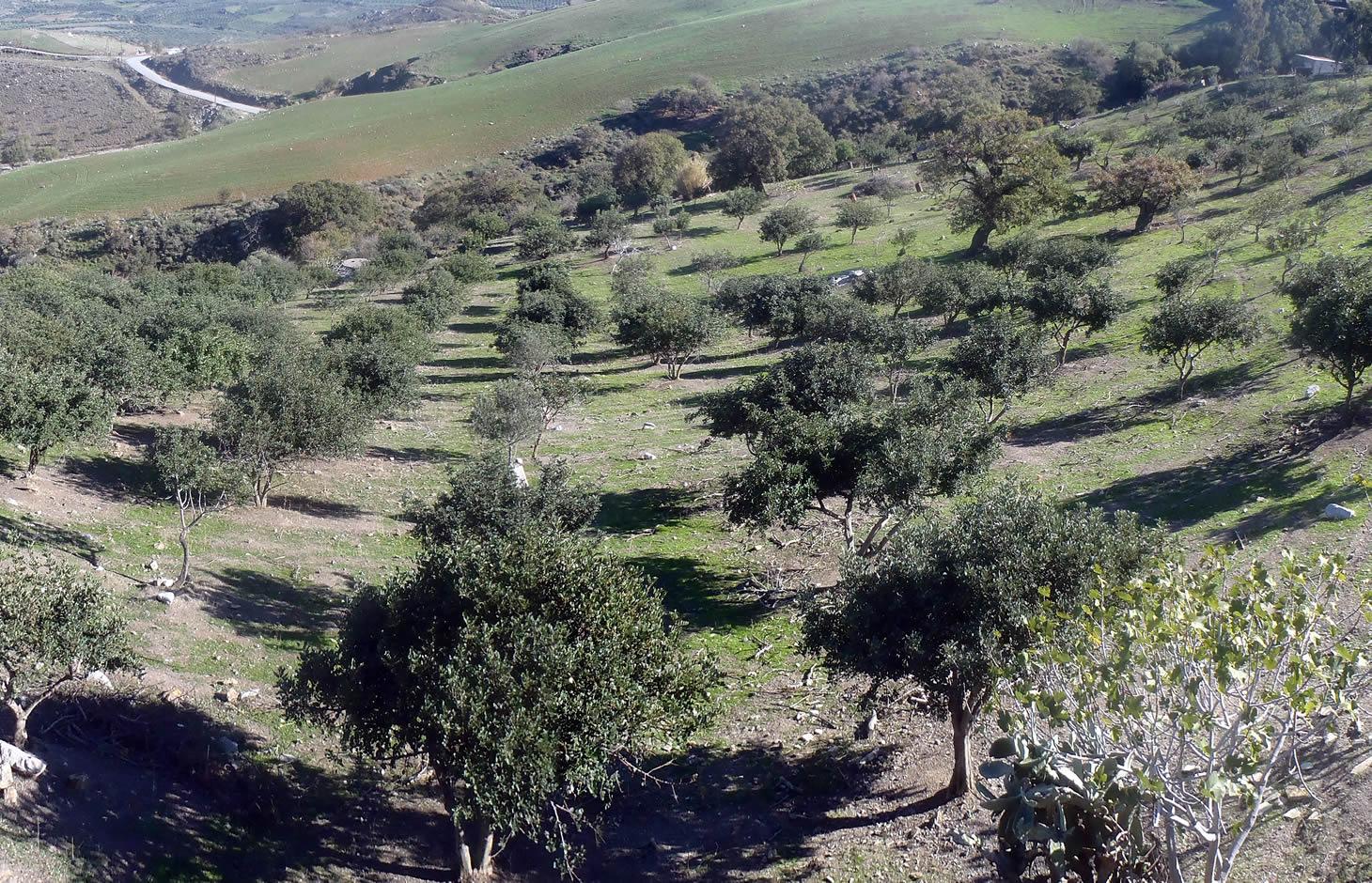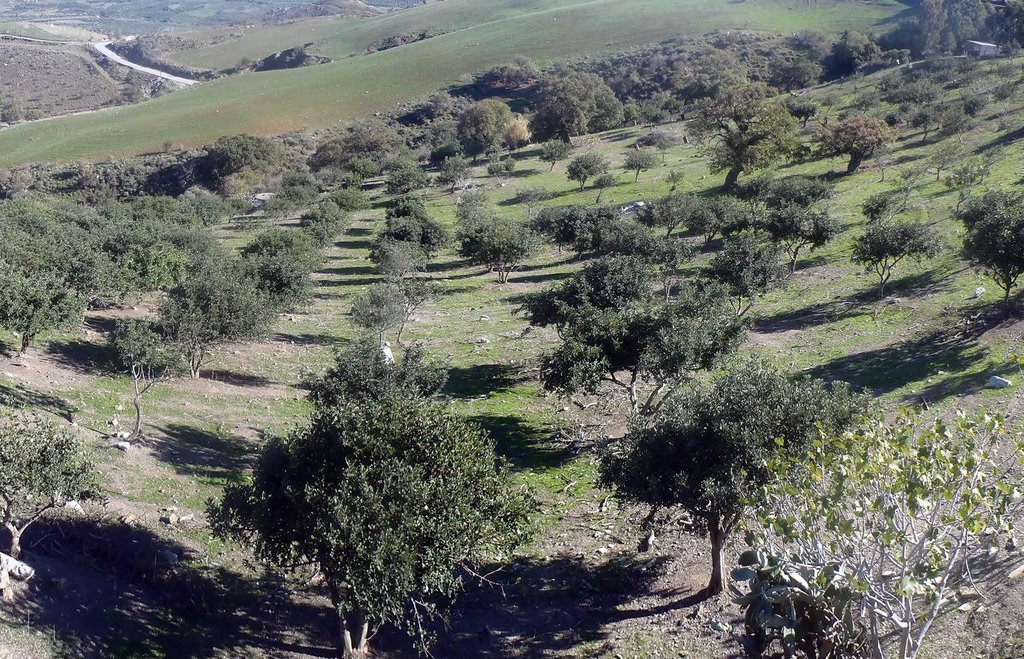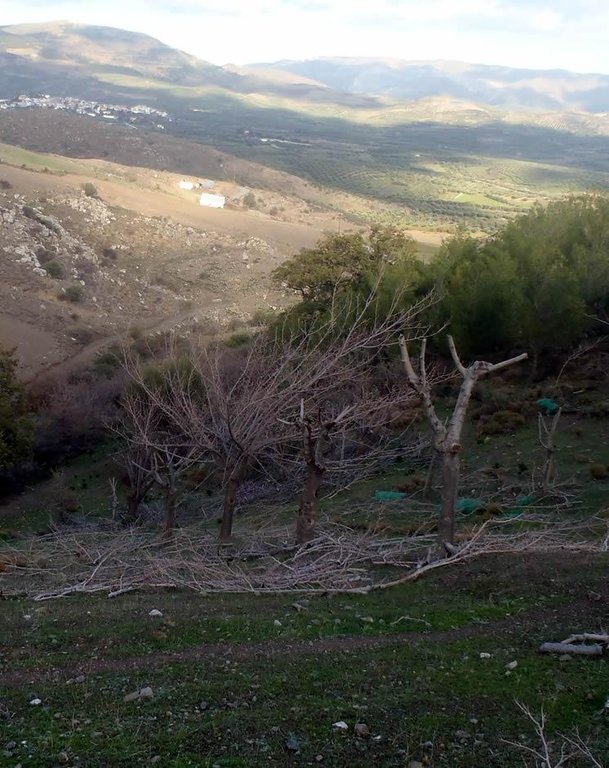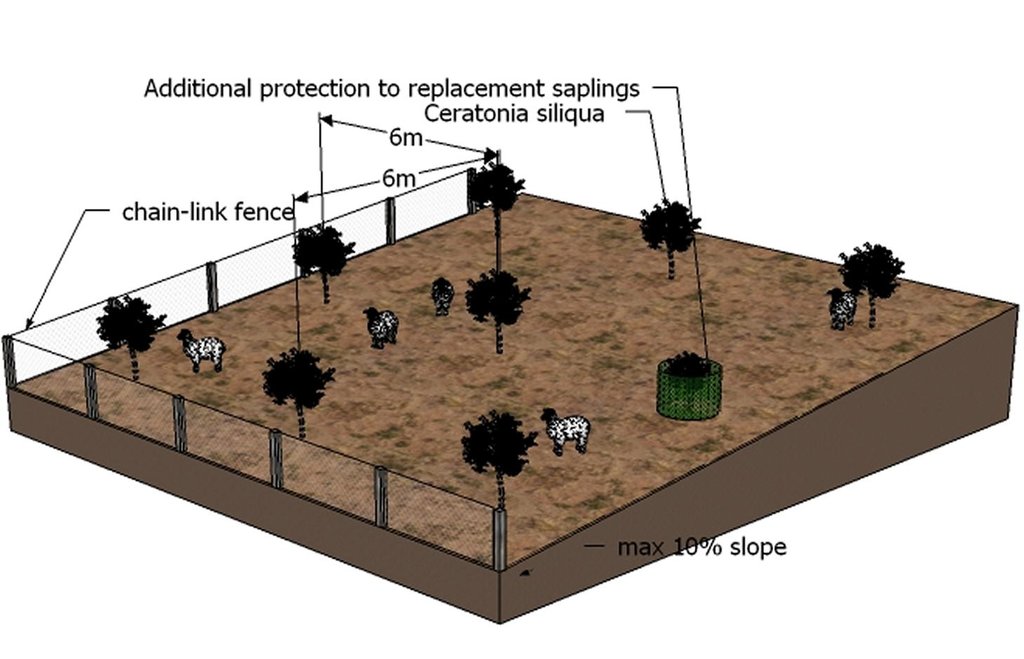Grazing land afforestation with Ceratonia siliqua (carob trees) in the Mediterranean [Greece]
- Creation:
- Update:
- Compiler: Ioannis Daliakopoulos
- Editor: –
- Reviewers: Deborah Niggli, Alexandra Gavilano
Φύτευση βοσκότοπου με Ceratonia siliqua (χαρουπιές) στη Μεσόγειο (EL)
technologies_1600 - Greece
View sections
Expand all Collapse all1. General information
1.2 Contact details of resource persons and institutions involved in the assessment and documentation of the Technology
SLM specialist:
Tsanis Ioannis
Technical University of Crete, Greece
Greece
Name of project which facilitated the documentation/ evaluation of the Technology (if relevant)
Catastrophic shifts in drylands (EU-CASCADE)Name of the institution(s) which facilitated the documentation/ evaluation of the Technology (if relevant)
Technical University of Crete (Technical University of Crete) - Greece1.3 Conditions regarding the use of data documented through WOCAT
The compiler and key resource person(s) accept the conditions regarding the use of data documented through WOCAT:
Yes
1.4 Declaration on sustainability of the described Technology
Is the Technology described here problematic with regard to land degradation, so that it cannot be declared a sustainable land management technology?
No
2. Description of the SLM Technology
2.1 Short description of the Technology
Definition of the Technology:
Graze land forestation with Ceratonia siliqua (carob trees)
2.2 Detailed description of the Technology
Description:
A stand of Ceratonia siliqua (carob trees) is established within an area used for grazing. Tree density is average (6 m grid configuration) and the majority of maintenance input is limited to the first 3 years. Once established, grazing can continue with few limitations. Ceratonia siliqua (carob tree) is very characteristic of the Mediterranean region, thus blending in very well with the local landscape, especially in the rugged agro-pastoral areas of the Mediterranean islands.
After the successful establishment of the plantation, intense irrigation is no longer required and livestock can be allowed in the afforested area which has been upgraded to an improved agro-pastoral or agroforestry land. This improvement facilitates a healthier ecosystem that mitigates land degradation by stabilizing soil, increasing infiltration and organic matter and promoting flora and fauna. In addition to those traits, Ceratonia siliqua is fire resistant and can promote market diversification for the farmer. The main drawback of this technology is the reduction in livestock and other crop production during the first decade of application until trees are mature.
The purpose of this technology is multifold. The primary goal is to increase ecosystem services provided by the treated area, especially for grazing. The farmer takes advantage of the qualities of carob trees for providing:
(a) Fodder to the livestock from the carob pods as well as leaves from cuttings;
(b) Shade to the livestock during the summer months;
(c) Better soil retention, water infiltration etc.
A secondary goal is to increase market diversification with the direct exploitation of carob beans for various products, such as carob honey and carob flour. These products give added value to the land and allow the farmer to increase his income in a more sustainable way.
At the same time much is gained from various other ecosystem services relevant to habitat and supporting services for the fauna of the area, such as birds and honey-bees. The aesthetic value of the landscape which strongly linked with Cretan traditions and pastoralism lifestyle is enhanced. The touristic attraction of the area is greatly improved providing new options for recreational activities and exploitation through actions such as agro-tourism.
Initially, few structural measures are required, mostly related to preparing slopes and soil for sapling planting and establishing irrigation infrastructure. A palisade that will effectively prevent livestock from damaging young trees needs to be maintained during the first 10 years of application of the technology. 2-year-old saplings are planted in a grid configuration with spacing of 6 m and actively managed for at least 3 years. Management includes watering, fertilization and replacement of dead or weak saplings.
The average annual precipitation in the area is 690 mm and the climate is classified as subhumid. Average annual temperature is 17.5 oC with 7 months below 18 but above 5, thus classifying the area as subtropical. In the location where the technology is applied, land is mostly individually owned and distributed among a few families of a community of about 100 inhabitants. Although the financial means of the land user who applies this technology are more or less on par with those of the rest of the community, he has a wider empirical education and relatively higher social status acquired thought his involvement with the commons.
2.3 Photos of the Technology
2.5 Country/ region/ locations where the Technology has been applied and which are covered by this assessment
Country:
Greece
Region/ State/ Province:
Heraklion
Further specification of location:
Melidochorion/Kastriotis
Comments:
Total area covered by the SLM Technology is 0.05 km2.
2.6 Date of implementation
If precise year is not known, indicate approximate date:
- 10-50 years ago
2.7 Introduction of the Technology
Specify how the Technology was introduced:
- through projects/ external interventions
3. Classification of the SLM Technology
3.1 Main purpose(s) of the Technology
- improve production
- reduce, prevent, restore land degradation
3.2 Current land use type(s) where the Technology is applied
Land use mixed within the same land unit:
Yes
Specify mixed land use (crops/ grazing/ trees):
- Agro-pastoralism (incl. integrated crop-livestock)

Cropland
- Tree and shrub cropping
Tree and shrub cropping - Specify crops:
- carob

Grazing land
Comments:
Tree and shrub cropping: Ceratonia siliqua (carob tree)
Major land use problems (compiler’s opinion): The main problems are reduced land cover that progressively leads to soil erosion, combined with the lack of sufficient water resources in the wider area.
Major land use problems (land users’ perception): Land users perceive a problem of reduced pasture fodder availability thus residing to more expensive solutions
Livestock density: 50-100 LU /km2
3.4 Water supply
Water supply for the land on which the Technology is applied:
- mixed rainfed-irrigated
3.5 SLM group to which the Technology belongs
- natural and semi-natural forest management
- agroforestry
- pastoralism and grazing land management
3.6 SLM measures comprising the Technology

vegetative measures
- V1: Tree and shrub cover

structural measures
- S6: Walls, barriers, palisades, fences
Comments:
Type of vegetative measures: aligned: -linear
3.7 Main types of land degradation addressed by the Technology

soil erosion by water
- Wt: loss of topsoil/ surface erosion

biological degradation
- Bc: reduction of vegetation cover
- Bq: quantity/ biomass decline
Comments:
Main causes of degradation: overgrazing
Secondary causes of degradation: education, access to knowledge and support services
3.8 Prevention, reduction, or restoration of land degradation
Specify the goal of the Technology with regard to land degradation:
- prevent land degradation
- restore/ rehabilitate severely degraded land
4. Technical specifications, implementation activities, inputs, and costs
4.1 Technical drawing of the Technology
Technical specifications (related to technical drawing):
A stand of Ceratonia siliqua (carob trees) is established within an area used for grazing. For at least 10 years the area is fenced adequately to exclude livestock; once trees are mature sheep can return to graze. If a tree needs to be replaced after establishment, it can be individually fenced.
Technical knowledge required for field staff / advisors: moderate (advice from technical staff is required for each of the plantation establishment stages)
Technical knowledge required for land users: moderate
Main technical functions: improvement of ground cover
Secondary technical functions: improvement of topsoil structure (compaction), stabilisation of soil (eg by tree roots against land slides), increase in organic matter, promotion of vegetation species and varieties (quality, eg palatable fodder), control of fires
Aligned: -linear
Vegetative material: T : trees / shrubs
Number of plants per (ha): 120
Vertical interval within rows / strips / blocks (m): 6
Width within rows / strips / blocks (m): 6
Trees/ shrubs species: Ceratonia siliqua
Construction material (other): chain-link fence
Author:
I. Daliakopoulos
4.2 General information regarding the calculation of inputs and costs
other/ national currency (specify):
Euro
If relevant, indicate exchange rate from USD to local currency (e.g. 1 USD = 79.9 Brazilian Real): 1 USD =:
0.73
Indicate average wage cost of hired labour per day:
80.00
4.3 Establishment activities
| Activity | Timing (season) | |
|---|---|---|
| 1. | Planting saplings | Winter |
| 2. | Grafting | in the 4th year of establishment |
| 3. | Slope/soil preparation | Before planting |
| 4. | Chain-link fencing | Before planting |
| 5. | Irrigation piping | Before planting |
4.4 Costs and inputs needed for establishment
| Specify input | Unit | Quantity | Costs per Unit | Total costs per input | % of costs borne by land users | |
|---|---|---|---|---|---|---|
| Labour | labour | ha | 1.0 | 3760.0 | 3760.0 | |
| Equipment | machine use | ha | 1.0 | 3020.0 | 3020.0 | |
| Plant material | seedlings | ha | 1.0 | 820.0 | 820.0 | |
| Construction material | chain-link fence | ha | 1.0 | 1900.0 | 1900.0 | |
| Construction material | pipes | ha | 1.0 | 270.0 | 270.0 | |
| Total costs for establishment of the Technology | 9770.0 | |||||
| Total costs for establishment of the Technology in USD | 13383.56 | |||||
4.5 Maintenance/ recurrent activities
| Activity | Timing/ frequency | |
|---|---|---|
| 1. | Fertilization | |
| 2. | Replacing dead or weak trees | whenever necessary |
| 3. | Pruning | once a year |
| 4. | Watering | twice per month during summer, once per month during the rest of the year |
4.6 Costs and inputs needed for maintenance/ recurrent activities (per year)
| Specify input | Unit | Quantity | Costs per Unit | Total costs per input | % of costs borne by land users | |
|---|---|---|---|---|---|---|
| Labour | labour | ha | 1.0 | 350.0 | 350.0 | |
| Plant material | seedlings | ha | 1.0 | 280.0 | 280.0 | |
| Fertilizers and biocides | fertilizer | ha | 1.0 | 160.0 | 160.0 | |
| Construction material | water | ha | 1.0 | 6.0 | 6.0 | |
| Total costs for maintenance of the Technology | 796.0 | |||||
| Total costs for maintenance of the Technology in USD | 1090.41 | |||||
5. Natural and human environment
5.1 Climate
Annual rainfall
- < 250 mm
- 251-500 mm
- 501-750 mm
- 751-1,000 mm
- 1,001-1,500 mm
- 1,501-2,000 mm
- 2,001-3,000 mm
- 3,001-4,000 mm
- > 4,000 mm
Specifications/ comments on rainfall:
690 mm
Agro-climatic zone
- sub-humid
Thermal climate class: subtropics
5.2 Topography
Slopes on average:
- flat (0-2%)
- gentle (3-5%)
- moderate (6-10%)
- rolling (11-15%)
- hilly (16-30%)
- steep (31-60%)
- very steep (>60%)
Landforms:
- plateau/plains
- ridges
- mountain slopes
- hill slopes
- footslopes
- valley floors
Altitudinal zone:
- 0-100 m a.s.l.
- 101-500 m a.s.l.
- 501-1,000 m a.s.l.
- 1,001-1,500 m a.s.l.
- 1,501-2,000 m a.s.l.
- 2,001-2,500 m a.s.l.
- 2,501-3,000 m a.s.l.
- 3,001-4,000 m a.s.l.
- > 4,000 m a.s.l.
5.3 Soils
Soil depth on average:
- very shallow (0-20 cm)
- shallow (21-50 cm)
- moderately deep (51-80 cm)
- deep (81-120 cm)
- very deep (> 120 cm)
Topsoil organic matter:
- medium (1-3%)
5.4 Water availability and quality
Ground water table:
> 50 m
Availability of surface water:
medium
Water quality (untreated):
good drinking water
5.5 Biodiversity
Species diversity:
- high
5.6 Characteristics of land users applying the Technology
Off-farm income:
- > 50% of all income
Relative level of wealth:
- average
Individuals or groups:
- individual/ household
Gender:
- men
Indicate other relevant characteristics of the land users:
Land users applying the Technology are mainly Leaders / privileged
Population density: < 10 persons/km2
Annual population growth: negative; 1%
5.7 Average area of land used by land users applying the Technology
- < 0.5 ha
- 0.5-1 ha
- 1-2 ha
- 2-5 ha
- 5-15 ha
- 15-50 ha
- 50-100 ha
- 100-500 ha
- 500-1,000 ha
- 1,000-10,000 ha
- > 10,000 ha
Is this considered small-, medium- or large-scale (referring to local context)?
- medium-scale
5.8 Land ownership, land use rights, and water use rights
Land ownership:
- individual, titled
Land use rights:
- individual
Water use rights:
- communal (organized)
5.9 Access to services and infrastructure
health:
- poor
- moderate
- good
education:
- poor
- moderate
- good
technical assistance:
- poor
- moderate
- good
employment (e.g. off-farm):
- poor
- moderate
- good
markets:
- poor
- moderate
- good
energy:
- poor
- moderate
- good
roads and transport:
- poor
- moderate
- good
drinking water and sanitation:
- poor
- moderate
- good
financial services:
- poor
- moderate
- good
6. Impacts and concluding statements
6.1 On-site impacts the Technology has shown
Socio-economic impacts
Production
fodder production
fodder quality
animal production
Comments/ specify:
during the first 10 years
wood production
risk of production failure
Comments/ specify:
30% failure rate
product diversity
Water availability and quality
demand for irrigation water
Income and costs
expenses on agricultural inputs
Comments/ specify:
after at least 10 years
diversity of income sources
Socio-cultural impacts
cultural opportunities
recreational opportunities
Comments/ specify:
agro-tourism opportunities
conflict mitigation
Ecological impacts
Water cycle/ runoff
surface runoff
Soil
soil moisture
soil cover
soil loss
nutrient cycling/ recharge
Biodiversity: vegetation, animals
biomass/ above ground C
plant diversity
animal diversity
beneficial species
habitat diversity
pest/ disease control
Climate and disaster risk reduction
fire risk
wind velocity
6.3 Exposure and sensitivity of the Technology to gradual climate change and climate-related extremes/ disasters (as perceived by land users)
Other climate-related consequences
Other climate-related consequences
| How does the Technology cope with it? | |
|---|---|
| droughts / dry spells for the first 3 years | not well |
6.4 Cost-benefit analysis
How do the benefits compare with the establishment costs (from land users’ perspective)?
Short-term returns:
negative
Long-term returns:
positive
How do the benefits compare with the maintenance/ recurrent costs (from land users' perspective)?
Short-term returns:
slightly negative
Long-term returns:
positive
6.5 Adoption of the Technology
Of all those who have adopted the Technology, how many did so spontaneously, i.e. without receiving any material incentives/ payments?
- 91-100%
Comments:
1 land user families have adopted the Technology with external material support
There is no trend towards spontaneous adoption of the Technology
6.7 Strengths/ advantages/ opportunities of the Technology
| Strengths/ advantages/ opportunities in the land user’s view |
|---|
| Increased income through the provision of free fodder for the livestock. |
| Restoration and protection of pastureland from further degradation. |
| Provision of additional market opportunities to the land user. |
| Strengths/ advantages/ opportunities in the compiler’s or other key resource person’s view |
|---|
| Restoration and protection of pastureland from further degradation. |
| Provision of additional market opportunities to the land user. |
6.8 Weaknesses/ disadvantages/ risks of the Technology and ways of overcoming them
| Weaknesses/ disadvantages/ risks in the land user’s view | How can they be overcome? |
|---|---|
| Decreased income though the reduction of livestock density (exclusion) for at least 10 years. | Receive financial assistance (subsidies) per excluded animal. Voluntary contribution of local farmers to benefit from economies of scale (for unions). |
| Decrease of vegetation under the tree canopy. | Reduce carob tree density. |
| Weaknesses/ disadvantages/ risks in the compiler’s or other key resource person’s view | How can they be overcome? |
|---|---|
| Decreased income though the reduction of livestock density (exclusion) for at least 10 years. | Receive financial assistance (subsidies) per excluded animal. |
| Cannot implement in higher altitude pastureland due to the nature of the carob tree. | Perform afforestation with Mulberries (Morus nigra) |
7. References and links
7.1 Methods/ sources of information
- field visits, field surveys
- interviews with land users
When were the data compiled (in the field)?
06/12/2013
Links and modules
Expand all Collapse allLinks
No links
Modules
No modules





